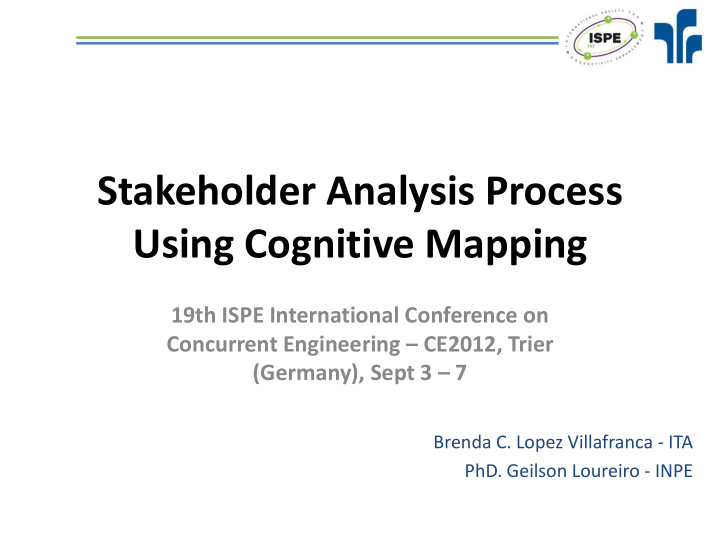



Stakeholder Analysis Process Using Cognitive Mapping 19th ISPE International Conference on Concurrent Engineering – CE2012, Trier (Germany), Sept 3 – 7 Brenda C. Lopez Villafranca - ITA PhD. Geilson Loureiro - INPE
Summary 1. Introduction 2. Stakeholder Analysis 3. Cognitive Maps 4. Stakeholder Analysis Process Using Cognitive Mapping 5. Advantages and Disadvantages 6. Conclusions 2
1. Introduction The stakeholder needs, most of the time are subjective, unclear, or even contradictory and must be translated into stakeholder requirements. The stakeholder requirements describe the problem supposed to be solved by the system of interest. The cognitive maps aim to deal with subjective information and problem structuring, both capabilities needed by the stakeholder analysis. 3
2. Stakeholder Analysis • A Stakeholder is any person or organization that affects or can be affected by the system of interest. • The Stakeholder Analysis refers to the study of how the stakeholders understand a specific problem, their point of view about it and their relation to it. 4
2. Stakeholder Analysis How to understand the stakeholders’ problem: • Understanding the way they perceive it; • Understanding how they structure it; and • Reaching the real needs. It does not mean that it is the correct way to represent the problem or even, if it is the real problem that should be analyzed; but this information must be elicited to get any conclusion. 5
3. Cognitive Map • Represents the mental model of an individual or group of individuals. • Helps to structure complex situations with subjective information, and assumptions. • Helps on the clarification of mental models and evokes reflection and analysis of the information exposed verbally, textually and graphically through the construction of the cognitive map process. 6
4. Stakeholder Analysis Using Cognitive Maps • The main purpose is to get to the root need through the continuous questioning to the stakeholder with generic WH questions, and specially the question Why? • The process is iterative by nature • Guide the thinking and reflection, changing several times the mental model of the stakeholder. 7
4. Stakeholder Analysis Using Cognitive Maps The stakeholders listens to the questions of the Systems Engineer. The stakeholder reflects about the problem and brings a mental model about it. The stakeholder expresses his mental model. As the verbal description arises, the reflection of the speech makes the stakeholder to feed the original mental model. The systems engineer creates a mental model or perception of the problem. The systems engineer represents the information as a cognitive map. The stakeholder views and reflects about the graphic representation of his point of view of the problem, which takes him into reflection to create a new mental model about the situation under review 8
4. Stakeholder Analysis Using Cognitive Maps STAKEHOLDER ANALYSIS PROCESS- IDEF0 Control - Stakeholder’s validation -Structured problem description - Relevant information for stakeholder requirements derivation I. -Needs Output Input Stakeholder - MoE’s -Constraints Analysis Process -Need statement -Assumptions -Existing documents -Etc. -Unofficial information - Rationale form the relevant information - Balanced understanding of the Mechanisms & problem among the stakeholders Resources involved and the requirements -Interaction with stakeholders engineer -Cognitive Mapping tool -Analysis -Two requirements engineers 9
4. Stakeholder Analysis Using Cognitive Maps 1.0 Analyse the Context 2.0 Construct Cognitive Maps 3.0 Analyse Cognitive Maps 4.0 Analyse the Problem 10
4.1 Analyze the Context STAKEHOLDER ANALYSIS PROCESS- IDEF0 Control - Stakeholder’s validation 1.0 Output Input - Context Analyze the Context -Need statement - List of stakeholders -Existing documents - List of scenarios (if applicable) - Unofficial information - Trigger question Mechanisms & Resources - Interview - Research - Analysis - 2 system engineers 11
4.2 Construct Cognitive Maps STAKEHOLDER ANALYSIS PROCESS- IDEF0 Control - Stakeholder’s validation 2.0 Output Input - Elicited information Construct Cognitive -Context - Individual maps validated Maps - List of Stakeholders - List of scenarios (if applicable) - Trigger questions Mechanisms & - Proposed Cognitive mapping Resources tool - Cognitive Mapping software - Analysis - 2 system engineers 12
4.3 Analyze Cognitive Maps STAKEHOLDER ANALYSIS PROCESS- IDEF0 Control - Stakeholder’s validation 3.0 Output Input - Integrated and validated map Analyze Cognitive - Structured problem - Elicited information Maps - Individual maps validated Mechanisms & - Proposed Cognitive mapping Resources tool - Cognitive Mapping software - Analysis - 2 system engineers 13
4.3 Analyze Cognitive Maps Cluster Capacity of Current Transmission Programming Electrical Interface Output - Integrated and validated map - Structured problem 14
4.4 Analyze the problem STAKEHOLDER ANALYSIS PROCESS- IDEF0 Control - Stakeholder’s validation 4.0 Output Input - Problem description Analyze the - Relevant information (needs, - Integrated and validated map Problem MoE’s , constraints, assumptions, - Structured problem desires, etc. - Rationale - Balanced understanding among stakeholders and system engineers Mechanisms & - Analysis Resources - 2 system engineers 15
4.4 Analyze the problem Real need Output Rationale - Problem description - Relevant information (needs, MoE’s , constraints, assumptions, desires, etc. - Rationale - Balanced understanding among stakeholders and system engineers 16
5. Advantages and Disadvantages Advantages Disadvantages • Knowledge • Trigger questions genertion • Several maps to • Leveled knowledge integrate • Exhaustiveness • Lack of elicitation completeness • Rationale capture 17
6. Conclusions The advantages proposed are worth enough to consider the cognitive mapping technique as part of the stakeholder analysis process. The critical issues to obtain a succeeded analysis are: • the complete involvement of the stakeholders. • the previous contextualization on the problem for the systems engineer. 18
Acknowledgements:
Recommend
More recommend